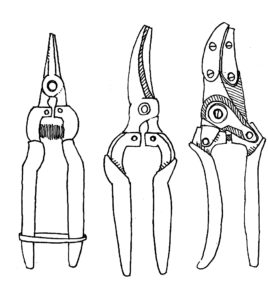The Right Tool for the Job
Tools are now and have always been vital to farming: They’re how we interact with the land to get things done. Whether it’s a stirrup hoe or a cultivating tractor, our favorite tools become extensions of our bodies, as we use them again and again.

We farmers have a very interesting relationship with our tools
We farmers have a very interesting relationship with our tools. Nowhere have I seen more random and unlikely materials become useful tools than on a farm. As a group, farmers seem to be driven by the ethics of rugged individualism, frugality, and independence, and there’s no way we’re going to pay $59.99 for something we can make for free from scavenged materials around the farm (even if it takes us two weeks).
Small farmers are also caught in a void. “Gardening” tools sold at nurseries are largely overpriced, poorly designed, and way too dainty to get anything done on a farm. Conversely, most farm equipment is sized for huge producers with thousands of acres of commodity crops and is obviously unsuited for us smaller-scale folks. Thus, we’re forced to repurpose odd items found hidden in the recesses in the back of the barn, to buy antiquated equipment at auction, and to improvise our own tools.
For me, there was no better introduction to this phenomenon than apprenticing for a few seasons with Roy Brubaker on his organic vegetable farm in central Pennsylvania. Roy had a fierce imagination and a steady hand with an arc welder, and he hated to buy anything. This combination led to a steady stream of inventions pouring from his shop, some absurd and some amazing. I remember harvesting greens with a tool made from a food-processor blade and an electric drill, “harvesting” pesky sparrows and invasive starlings in a human-size trap, and watering transplants using harvested rainwater from a reclaimed milk tank on a semi. We even had an old Dodge Colt that was converted for use as sort of a field-delivery wagon. We’d drive it down the farm lane, filled with sacks of fertilizer for the transplanting crew, and return to the packing shed overloaded with boxes of melons or bunches of beets from the harvest crew. Once, in a pinch, I picked up my mother from the hospital after a serious bacterial infection in our “Crop Car.” It was actually a pleasant ride. Mom napped in the front while a fresh breeze whipped through the missing window seals and wafted the scent of organic fertilizer through the car.
Roy loved working in his shop and would do so as often as the constraints of farming would allow him. I remember him struggling through a chilly spring day of harvest with a serious cold, hacking and coughing all the while. Later that night, I found him in the shop, the temperature even colder, welding away. “I’m starving my cold,” he said. I think he figured if the conditions were tough on him, they had to be even worse for whatever virus had infected his lungs. Sure enough, the following day yielded a chipper and smiling Roy, complete with a new creation from his shop in hand.
He never passed up the chance to create his own solution for whatever problem arose on the farm, even if he could buy one relatively inexpensively. We had homemade opening devices for our greenhouse ventilation windows, a homemade spool to distribute our plastic packing bags, and a homemade barrel washer to clean our root crops.
Were all these homemade tools worth the effort it took to make them? Did they really improve our efficiency? Did Roy get a proper return on all the time he spent in the shop? The answers are immaterial. I learned a lot from working with someone who was unafraid to exercise creativity to solve a problem rather than reach for an off-the-shelf solution.
During my second winter in Pennsylvania, I was midway through building a set of harvest crates from a poplar harvested from the farm when I realized that, for me, the most valuable part of farming lies in the process, not in the number of pounds of produce harvested at the end of the season.
That said, tools for small farmers are starting to become more available. New companies are springing up and old ones are expanding their product lines to supply high-quality equipment to farmers of all scales. It’s a welcome change, as there’s nothing more frustrating than struggling through a task with a poorly designed tool. Ultimately, I think tools are at their best when they’re well planned, properly made, and efficient to use but still carry some of our collective farmers’ soul. My favorite chore is digging burdock roots using the “Kentifer” weeding tool that Roy made for me in his shop from a piece of old truck spring steel (the original model was built as a wedding gift for two of his earliest apprentices, Kent and Jennifer). It’s a joy to use, and brings back a lot of good memories every time I pull it out of the tool shed.
Excerpted from Greenhorns: 50 Dispatches from the New Farmers’ Movement (c) Zoe Ida Bradbury, Paula Manalo, and Severine von Tscharner Fleming. Used with permission of Storey Publishing

